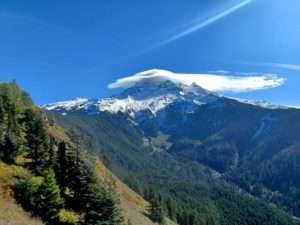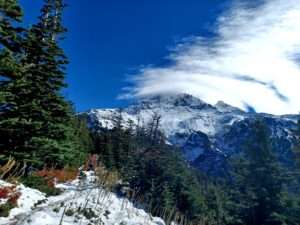 Have you ever seen weird clouds that looked like saucers (flying or otherwise), or piles of pancakes floating in the air? That’s not a pie in the sky, but the appearance of lenticular clouds! I was fortunate enough to get to observe one in detail on a recent hike in the Cascades.
Have you ever seen weird clouds that looked like saucers (flying or otherwise), or piles of pancakes floating in the air? That’s not a pie in the sky, but the appearance of lenticular clouds! I was fortunate enough to get to observe one in detail on a recent hike in the Cascades.
Earlier this month I took a couple of days off to go to Portland and then head out to Mt. Hood to climb the Timberline trail toward McNeil Point. I haven’t been on this hike in a few years, and I knew that with increased precipitation my window of opportunity would soon snap shut. I am not a snowshoer, and I tend to like my trails visible without having to use blazes or blue diamonds. So I packed my dog in the car and got an early start to make the drive out to the Top Spur trailhead.
Unsurprisingly, the storm system that had come through the previous day left its mark in the form of patches of snow. Coming up through the forest was easy enough, and by the time I made it to Bald Mountain’s south face the sun had dried the trail nicely. This allowed me to enjoy that spectacular view of Mt. Hood–or, more traditionally, Wy’East, as the Multnomah originally named it. The mountain was wearing a hat this day in the form of a lenticular cloud, with a bit of a tail hanging off toward the south. Like other lenticular clouds it looked a little like a UFO hovering over the peak.
I’d never had the chance to see one of these this close; in fact, the last time I had seen lenticular clouds was August 28, 2016, when atmospheric conditions were just right for dozens of these strange formations to appear all throughout the Columbia River Gorge. I was lucky enough to have an appointment out toward Hood River that day, and my trip was punctuated by ever-greater numbers of saucer-shaped clouds floating overhead. Still, they were higher in the air at the time, whereas my view from Bald Mountain allowed me a closer look, and got me thinking about the origin of these unusual “UFO clouds”.
How Do Lenticular Clouds Form?
The formal name for lenticular clouds is Altocumulus Standing Lenticular Clouds. In spite of the fact that they look as though they are not moving, they’re actually constantly forming, dissipating, and re-forming. Their still appearance belies a great deal of turbulence, and aircraft pilots often use these as a warning to stay far away from whatever high point the clouds are forming around.
It takes just the right set of conditions for lenticular clouds to appear. First, there needs to be a high altitude obstacle, such as a mountain. Because it is high profile, it interferes with air currents, and the mountain becomes something like a speed bump. If the air is stable and fast moving, this causes it to ripple, and if there’s enough humidity for clouds to form within this ripple, they take the characteristic lenticular shape.
Lenticular clouds aren’t always caused by a solid barrier. The shear winds caused by incoming thunderstorms and other severe weather systems can sometimes be enough to cause the clouds to form, even in an otherwise clear sky. This is what is known in aviation as Clear Air Turbulence, and it can be incredibly dangerous to aircraft in flight. Sometimes lenticular clouds are the only visual cue that there’s a disturbance.
As Above, So Below
Unfortunately for me, the air wasn’t the only thing experiencing turbulence that day. By the time I had hiked a couple of miles in the trail was turning to a mess of mud and slush that offered poor footing at best, even with good hiking boots. We broke out of the younger forest along the ridge up from Bald Mountain, and encountered a couple of people coming from further ahead who said that conditions were even worse there.
 I headed up just a little more to take a few pictures of the valley that contained the beginning of the Muddy Fork of the Sandy River. Then I turned around, and we headed back down the way we came. The fact that neither human nor dog ended up wiping out on the slippery slope was well-nigh miraculous, and we made it back to the car muddy and wet, but glad for the chance to get out for a few hours.
I headed up just a little more to take a few pictures of the valley that contained the beginning of the Muddy Fork of the Sandy River. Then I turned around, and we headed back down the way we came. The fact that neither human nor dog ended up wiping out on the slippery slope was well-nigh miraculous, and we made it back to the car muddy and wet, but glad for the chance to get out for a few hours.
As I rounded the last bend before Bald Mountain obscured Wy’East, I took one last look at Wy’east and its hat, which by now had frayed from an ever-shifting series of lenticular clouds into a pile of fluff sliding off the mountain’s southern slope. As I always do at this point on the trail, I told Wy’east I would be back someday, and then we descended into the shadows of the forest.
Want to follow more of my adventures and learn cool stuff about nature? Here’s where you can join my monthly mailing list, add my Facebook page, and otherwise keep track of news and updates about my classes, articles, and much more!
